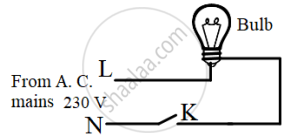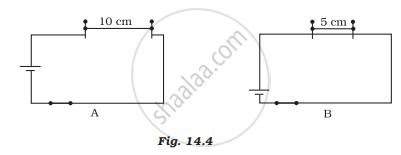Advertisements
Advertisements
प्रश्न
Explain the importance/uses of fuse wire.
उत्तर
- Fuse is an important application of heating effect of electric current used in electric circuits.
- It protects circuits and appliances by stopping the flow of any excess electric current.
- If a current larger than the specific value flows through the circuit, the temperature of fuse wire increases. This melts the fuse wire and breaks the circuit.
- In summer season, when consumption of electrical power is huge in the evening due to home lighting, fan, air conditioner, use of electricity in shops etc, an excessive current is drawn from the transformer. If the capacity of the transformer is insufficient, its fuse wire melts, and the supply gets shut down.
संबंधित प्रश्न
Compute the heat generated while transferring 96000 coulomb of charge in one hour through a potential difference of 50 V.
An electric heater of resistance 8 Ω draws 15 A from the service mains 2 hours. Calculate the rate at which heat is developed in the heater.
How does the resistance of a wire vary with its area of cross-section?
Write Joule's law of heating.
An electric room heater draws a current of 2.4 A from the 120 V supply line. What current will this room heater draw when connected to 240 V supply line?
What is nichrome? State its one use.
Why are the coils of electric irons and electric toasters made of an alloy rather than a pure metal?
Why is a series arrangement not used for connecting domestic electrical appliances in a circuit?
How much heat will an instrument of 12 W produce in one minute if it is connected to the heat produced by it?
The current passing through a room heater has been halved. What will happen to the heat produced by it?
What is meant by the heating effect of current? Give two applications of the heating effect of current.
The current passing through an electric kettle has been doubled. The heat produced will become:
(a) half
(b) double
(c) four time
(d) one-fourth
The heat produced in a wire of resistance 'x' when a current 'y' flows through it in time 'z' is given by:
(a) x2 × y × z
(b) x × z × y2
(c) y × z2 × x
(d) y × z × x
Which of the following characteristic is not suitable for a fuse wire?
(a) thin and short
(b) thick and short
(c) low melting point
(d) higher resistance than rest of wiring
How does the wire in the filament of a light bulb behave differently to the other wires in the circuit when the current flows?
What property of the filament wire accounts for this difference?
Which electric heating device in your home do you think have resistors which control the flow of electricity?
Solve the following example.
Heat energy is being produced in a resistance in a circuit at the rate of 100 W. The current of 3 A is flowing in the circuit. What must be the value of the resistance?
Write scientific reason.
A coil made up of alloy Nichrome is used in the electric heater cooker as a resistor.
True or False – If False give the correct answer
The fuse wire does not melts whenever there is overload in the wiring.
An electric iron draws a current of 4 A when connected to 220 V mains. Its resistance must be:
A fuse wire repeatedly gets burnt when used with a good heater. It is advised to use a fuse wire of:
An electric kettle consumes 1 kW of electric power when operated at 220 V. A fuse wire of what rating must be used for it?
How does use of a fuse wire protect electrical appliances?
Why is parallel arrangement used in domestic wiring?
(a) Observe the diagram given below and state whether the bulb will glow or not when we switch on K.

(b) Is it safe to handle the bulb when the switch is OFF?
(c) Give a reason for your answer in (b).
An electric component used as a safety device is electric circuit is ______.
Paheli took a wire of length of 10 cm. Boojho took a wire of 5 cm of the same material and thickness. Both of them connected the wires as shown in the circuit given in Figure 14.4. The current flowing in both circuits is the same.
(i) Will the heat produced in both cases be equal? Explain
(ii) Will the heat produced be the same if the wires taken by them are of equal lengths but of different thicknesses? Explain.

An electric fuse has a body made of ceramic and two points for connecting the fuse wire.
______ wire is used in the filament of the bulbs.
Assertion: A current-carrying wire should be charged.
Reason: The current in a wire is due to the flow of free electrons in a definite direction.
Name a few appliances which work on the basis of the heating effect of current.
A student boils water in an electric kettle for 20 minutes. Using the same mains supply he wants to reduce the boiling time of water. To do so should he increase or decrease the length of the heating element? Justify your answer.
An electric fuse is a wire made up of a material having ______ melting point.
In a set up the students coated iron nails with zinc metal and noted that, iron nails coated with zinc prevents rusting. They also observed that zinc initially acts as a physical barrier, but an extra advantage of using zinc is that it continues to prevent rusting even if the layer of zinc is damaged. Name this process of rust prevention and give any two other methods to prevent rusting.
What is the heating effect of electric current?
Write an expression for the amount of heat produced in a resistor when an electric current is passed through it stating the meanings of the symbols used.
An electric iron of resistance 20 Ω draws a current of 5 A. The heat developed in the iron in 30 seconds is ______.
